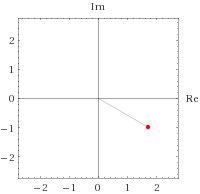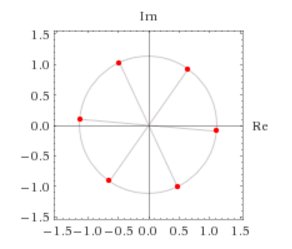How do you find the 6th root of #sqrt3-i #?
1 Answer
Let
First let us plot the point
And we will put the complex number into polar form:
# |omega| = sqrt(3+1) = 2 #
# arg(omega) = tan^-1(-1/sqrt(3)) = -(pi)/6 #
So then in polar form we have:
# omega = 2(cos(-(pi)/6) + isin(-(pi)/6)) #
We now want to solve the equation for
# z^6 = 2(cos(-(pi)/6) + isin(-(pi)/6)) #
Whenever dealing with complex variable equation such as this it is essential to remember that the complex exponential has a period of
# z^6 = 2(cos(2npi-(pi)/6) + isin(2npi-(pi)/6)) \ \ \ n in NN#
By De Moivre's Theorem we can write this as:
# z = {2(cos(2npi-(pi)/6) + isin(2npi-(pi)/6))}^(1/6)#
# \ \ = 2^(1/6)(cos((2npi-(pi)/6)/6) + isin((2npi-(pi)/6)/6))#
# \ \ = 2^(1/6)(cos theta + isin theta) \ \ \ \ # where# theta=((12n-1)pi)/36#
Put:
# n=1 => theta = (11pi)/36 => z = 2^(1/6)(cos ((11pi)/36)+ isin ((11pi)/36)) #
# n=2 => theta = (23pi)/36 => z = 2^(1/6)(cos ((23pi)/36)+ isin ((23pi)/36)) #
# n=3 => theta = (35pi)/36=> z = 2^(1/6)(cos ((35pi)/36)+ isin ((35pi)/36)) #
# n=4 => theta = (47pi)/36=> z = 2^(1/6)(cos ((47pi)/36)+ isin ((47pi)/36)) #
# n=5 => theta = (59pi)/36=> z = 2^(1/6)(cos ((59pi)/36)+ isin ((59pi)/36)) #
# n=6 => theta = (71pi)/36=> z = 2^(1/6)(cos ((71pi)/36)+ isin ((71pi)/36)) #
After which the pattern continues.
We can plot these solutions on the Argand Diagram



